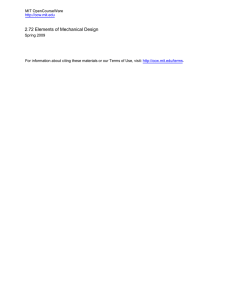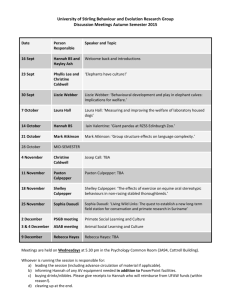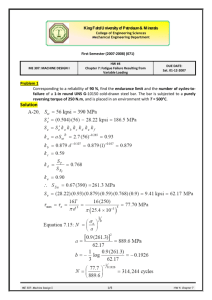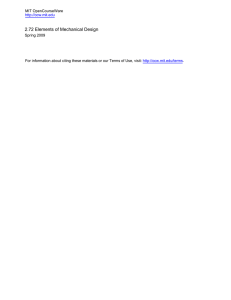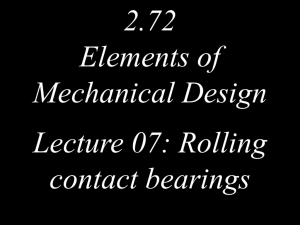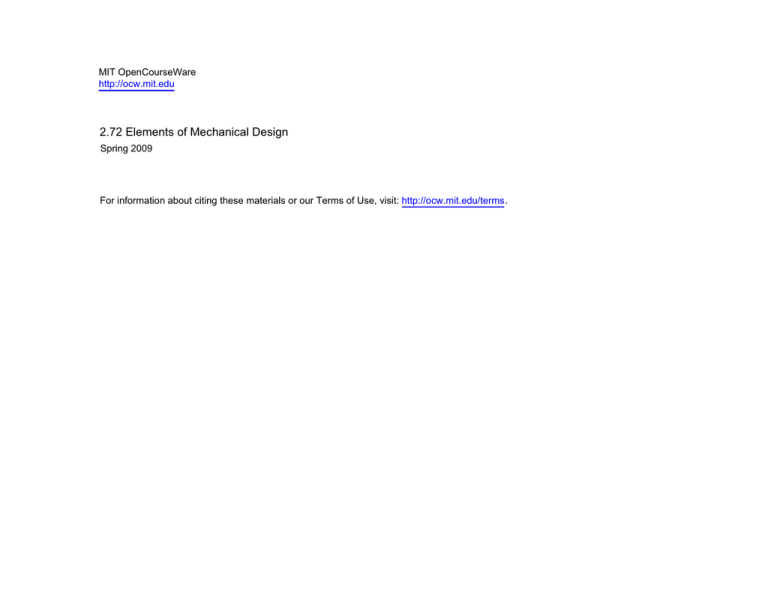
MIT OpenCourseWare
http://ocw.mit.edu
2.72 Elements of Mechanical Design
Spring 2009
For information about citing these materials or our Terms of Use, visit: http://ocw.mit.edu/terms.
2.72
Elements of
Mechanical Design
Lecture 04: Fatigue
Schedule and reading assignment
Reading quiz
Announcements
Shaft due date
Shaft exercise
Goodman diagram quiz (Tuesday)
see unterhausen. "fatigue crack." March 27, 2008.
Shear-moment qualifying quiz (Tuesday)
Please
YouTube. Accessed October 28, 2009.
http://www.youtube.com/watch?v=iBuuVd0JlIM
Topics
Discuss stiffness exercises
Start fatigue
Reading
None, for Tuesday, prep for quizzes in lab time (Given lounge, top of 35)
© Martin Culpepper, All rights reserved
2
Reading quiz
Discuss stiffness exercises
Answers
Intuition about stiffness
Carriage bearing-rail Part
Spindle
Carriage-rail
Etc…
Insight and perspective
Combined Stiffness K’
K’/2
K’/3
K’/4
K’/5
0
1
2
3
4
K’/K
© Martin Culpepper, All rights reserved
4
Shaft exercise
Are you on top of this!?
Fatigue part I
At what critical time in
engineering history did
fatigue became
relevant?
Why does fatigue
failure generate serious
concern?
What type of warnings
does one receive?
Fire plane wing failure
July 18, 2002 near Estes Park, Colorado
Both crew members killed
Delivered in July, 1945 to the U.S. Navy
Logged 8000+ flight hours
Investigation
NTSB found extensive fatigue
Cracks hidden from view
© Martin Culpepper, All rights reserved
Please see richmondlopez13. "Plane crash caught on tape - 6."
10
December 5, 2007. YouTube.
Accessed October 14, 2009. http://www.youtube.com/watch?v=j7kr6o1s9sI
Comet airplane failures
BOAC Flight 781 crashes on 10 January 1954
Concluded fire was most likely cause
Resumed on 23 March 1954
Comet G-ALYY crashes on 8 April 1954
Pressure tests revealed fatigue
Windows to be glued & riveted, but riveted only
Square windows ĺ oval
Skin thickened
Service in 1958
© Martin Culpepper, All rights reserved
11
I-35 bridge failure
By Laurie Blake, Paul Mcenroe, Pat Doyle and Tony Kennedy, Star Tribune
MnDOT’s options:
Make repairs or find flaws & bolt on steel plating
Fueled emotional debate
MNDOT’s action:
Image from Wikimedia Commons, http://commons.wikimedia.org
Thousands of bolt holes would weaken bridge
Launched inspection, interrupted by work on bridge surface
The state's top bridge engineer:
"We chose the inspection route….. We thought we had done all we could, but obviously something went terribly wrong."
"Up until the late 1960s, it was thought that fatigue was not a phenomenon you would see in bridges.”
© Martin Culpepper, All rights reserved
12
How much do engineers
know about fatigue?
How “exact” are
fatigue models?
Experimental data
80
70
60
Peak alternating bending stress S, kpsi (log)
50
40
35
30
25
Wrought
20
18
16
14
Permanent mold cast
12
10
Sand cast
8
7
6
5
103
104
105
106
107
108
109
Life N, cycles (log)
Figure by MIT OpenCourseWare. Adapted from Fig. 6-11 in Shigley & Mischke .
© Martin Culpepper, All rights reserved
14
Experimental data
140
120
Endurance limit S'e, kpsi
0.5
S1e
= 0.6
Su
0.4
105 kpsi
100
80
60
40
Carbon steels
Alloy steels
Wrought irons
20
0
0
20
40
60
80
100
120
140
160
180
200
220
240
260
280
300
Tensile strength Sut, kpsi
Figure by MIT OpenCourseWare. Adapted from Fig. 6-17 in Shigley & Mischke.
© Martin Culpepper, All rights reserved
15
What actions and/or
practices should be put
in place as a result?
Testing and prevention
Where life-limb-$ are important
It is your job to spec out test type and procedure
Balance of cost vs. risk
Many people listen to REAL data
Example types
Ultrasonic
Liquid penetrant
Stiffness/impulse
Eddy-current
Leaks
Visual
Few people listen to Eqxns
A choice: Job vs. safety
Images removed due to copyright restrictions.
Please see http://www.labino.com/bilder/applications/00533_RT8.jpg
http://www.riverinaairmotive.com.au/img/mpi001.jpg
On foreseeable use
Common sense
Legal
© Martin Culpepper, All rights reserved
17
Where do cracks come
from?
Potential crack origins/causes
Inherent to material
Imperfections, e.g. castings
Precipitates, e.g. Al 6061 T6
Coalescing of internal dislocations
Grain boundaries
Image removed due to copyright restrictions. Please see
http://www.emeraldinsight.com/fig/2190080205007.png
Fabrication-related
Tool marks
Improper assembly, e.g. forcing (car suspension-cast materials)
Thermally induced - Weld cracks and related HAZ problems
Use-related
High stress areas
Scratches
Unintended use/damage/loading (e.g. 3 finger tight and paint lid)
© Martin Culpepper, All rights reserved
19
Fatigue: Origin of problem
Images removed due to copyright restrictions. Please see:
http://www.metallographic.com/Images/Zn-Al.jpg
http://corrosionlab.com/Failure-Analysis-Studies/Failure-Analysis-Images/
20030.SCC.304H-pipeline/20030.microstructure-ditched-grain-boundaries.jpg
and
Fig. 4b in Henderson, Donald W., et al. "The Microstructure of Sn in Near-Eutectic Sn-Ag-Cu Alloy Solder Joints and its Role
in Thermomechanical Fatigue." Journal of Materials Research 19 (June 2004): 1608-1612
or
Slide 36 in Kang, Sung K. "Near-Ternary Sn-Ag-Cu Solder Joints; Microstructure, Thermal Fatigue, and Failure Mechanisms."
Pb-Free Workshop, TMS Annual Meeting, February 2005.
© Martin Culpepper, All rights reserved
20
Fatigue life review
Low cycle High cycle
Log(S)
Sut
Se
Log(103)
© Martin Culpepper, All rights reserved
Log(106)
Log(N)
21
Fatigue life review
Ferrous materials/allows: Se ~ 1 000 000 – 10 000 000
Under ideal conditions
Non-ferrous (i.e. aluminum) generally no Se…
Do we use Al in places where fatigue is important?…
Aircraft…
History Channel Boneyard…
Low cycle High cycle
Methods
Stress
Strain
Fracture mechanics
© Martin Culpepper, All rights reserved
Sut
Log(S)
Science vs. engineering…
Se
Log(103)
Log(106)
Log(N)
22
Fatigue and ethical responsibility
You will be criminally
negligent if you do not
augment calculations
with TESTING for
critical fatigue
applications
Life-limb-$
© Martin Culpepper, All rights reserved
23
Real life
Please see datsun_laurel. "R06 Front Carbon ARB Fatigue Test." Photobucket. Accessed October 14, 2009.
http://s23.photobucket.com/albums/b388/datsun_laurel/FSAE/?action=view&current=ARB_Test.flv
© Mart n Culpepper,
i
All r ghts ireserved
24
Real life
http://video.google.com (author?)
Please see SmithersMpls. "Carbon Frame Fatigue Test." February 9, 2007. YouTube.
© Martin Culpepper, All rights reserved Accessed October 14, 2009. http://www.youtube.com/watch?v=QHO_VjVhaE8
25
Real life
http://yourdailymedia.com
© Martin Culpepper, All rights reserved
26
Please see motocross. "The Nitro Circus: Channel 9 Action News." March 3, 2009. YouTube. Accessed October 14, 2009.
http://www.youtube.com/watch?v=kOaYruVcvm4
What reasonable
hypotheses could one
hold for identifying
important factors?
Fatigue life modifiers
Experimental results are used to obtain modifiers
Se = ( ka kb kc kd ke k f ) S'e
Where:
ka
kb
kc
kd
ke
kf
=
=
=
=
=
=
Surface condition modification factor
Size modification factor
Load modification factor
Temperature modification factor
Reliability modification factor
Others…
S’e
Se
=
=
Rotary-beam test endurance limit Predicted endurance limit for your part © Martin Culpepper, All rights reserved
28
Endurance limit depends on many factors
For ferrous materials, the following approximations may
be used for first pass design
S'e =
0.5 Sut
Sut d 200kpsi
100kpsi
Sut ! 200kpsi
700MPa Sut ! 1400MPa
This is for ideal conditions… but designs are never ideal
3
7 in
16
4.94
Aluminum alloy 7075-T73
Rockwell B 85.5
25.5
10.200
Vs.
0.30 in
7
9 in R.
8
© Martin Culpepper, All rights reserved
Lug (1 of 2)
Fracture
A
Figure by MIT OpenCourseWare. Adapted from Fig. 6-8 and 6-9 in Shigley & Mischke.
29
Experimental data
140
120
Endurance limit S'e, kpsi
0.5
S1e
= 0.6
Su
0.4
105 kpsi
100
80
60
40
Carbon steels
Alloy steels
Wrought irons
20
0
0
20
40
60
80
100
120
140
160
180
200
220
240
260
280
300
Tensile strength Sut, kpsi
Figure by MIT OpenCourseWare. Adapted from Fig. 6-17 in Shigley & Mischke.
© Martin Culpepper, All rights reserved
30
Fatigue life modifiers: Surface condition
Experimental results are used to obtain modifiers
ka = a S
b
ut
Where:
a = function of fabrication process
b = function of fabrication process
• Why does finish matter?
Surface finish
© Martin Culpepper, All rights reserved
Factor a
Exponent b
Sut, kpsi
Sut, MPa
Ground
1.34
1.58
-0.085
Machined or cold-drawn
2.70
4.51
-0.265
Hot-rolled
14.4
57.7
-0.718
As-forged
39.9
272.
-0.995
Figure by MIT OpenCourseWare. Adapted from Table 6-2 in Shigley & Mischke.
31
Why would surface
condition matter?
Surface roughness review
Mean
1 L
y Ra = L ⋅ ∫0 y dx
x
Common surface roughness (Ra in micro-inches)
Process
2000
1000
500
250
125
63
32
16
8
4
2
1
½
Sawing
Drilling
Milling
Turning
Grinding
Polishing
Only specify what you need & know your processes
© Martin Culpepper, All rights reserved
33
Why would part size
matter?
Fatigue life modifiers: Size factor
For bending and torsion of a round bar:
kb =
0.879 d
0.107
0.910 d
0.157
for 0.11in d 2.00in
for 2.00in d 10.0in
For axial loading:
kb = 1
What if the bar is not round?
Use a 95 percent stress area
Equate volumes, length drops out
Relate cross sectional area of round and square bar
d e = 0.808h b 0.5
© Martin Culpepper, All rights reserved
35
Why would the type of
loading matter?
Fatigue life modifiers: Loading factor
For bending and torsion of a round bar: 1.00
kc = 0.85
0.59
© Martin Culpepper, All rights reserved
bending
axial
torsion
37
Why would temperature
matter?
Fatigue life modifiers: Temperature factor
The effect of increasing temperature
Yield strength typically decreases May be no fatigue limit for material-temperature combos The temperature factor
May be ESTIMATED from existing tables
Should ALWAYS BE DETERMINED EXPERIMENTALLY FOR YOUR
GIVEN MATERIAL.
Relate strength at temperature to room temp. strength
ST
kd =
S RT
© Martin Culpepper, All rights reserved
39
Fatigue life modifiers: For an example steel
Temperature, oC
ST/SRT
o
Temperature, F
ST/SRT
20
1.000
70
1.000
50
1.010
100
1.008
100
150
1.020
1.025
200
300
1.020
1.024
200
1.020
400
1.018
250
1.000
500
0.995
300
350
0.975
0.943
600
700
0.963
0.927
400
0.900
800
0.872
450
0.843
900
0.797
500
550
0.768
0.672
1000
1100
0.698
0.567
600
0.549
Figure by MIT OpenCourseWare. Adapted from Table 6-4 in Shigley & Mischke.
© Martin Culpepper, All rights reserved
40
Part II
Calculations
How do statistics and
probability come into
play?
Standard normal distribution, mean = 0
Standard normal distribution curve generated via the
probability distribution
Area under the curve = 1
f (z ) =
1
σˆ x
This will be covered
in the 2nd design lab
⎡ 1 2⎤
exp ⎢ − (z ) ⎥
2π
⎣ 2
⎦
What if mean is not 0?
2
⎡
1 ⎛ x − μx ⎞ ⎤
1
⎟⎟ ⎥
exp ⎢ − ⎜⎜
f (x ) =
σˆ x 2π
⎢⎣ 2 ⎝ σˆ x ⎠ ⎥⎦
f (z )
Standard normal
distribution curve
© Martin Culpepper, All rights reserved
-1.1
0
z
43
Non-zero means in Gaussian distributions
A normal Gaussian distribution is typically observed in
fatigue behavior of parts
x = variate = x
z = transformation variate
σ = standard deviation
2
⎡
1
1 ⎛ x − μx ⎞ ⎤
⎟⎟ ⎥
f (x ) =
exp ⎢ − ⎜⎜
σˆ x 2π
⎢⎣ 2 ⎝ σˆ x ⎠ ⎥⎦
x − μx
z=
σˆ x
f (z ) =
1
σˆ x
Normal
distribution curve
⎡ 1 2⎤
exp ⎢ − (z ) ⎥
2π
⎣ 2
⎦
μ
Only one table for values needed to find the area
between z values…
© Martin Culpepper, All rights reserved
x
44
Fatigue life modifiers: Reliability factor
Normal
distribution curve
ȝ
x
x − μx
z=
σˆ x
© Martin Culpepper, All rights reserved
Standard normal
distribution curve
-1.1
0
x
45
Example use of standard normal distribution
In a shipment of 250 connecting rods, the mean tensile
strength is 45 kpsi and the standard deviation is 5 kpsi
z 39.5
(a) Assuming a normal distribution, how many rods may be expected to
have a strength less than 39.5 kpsi?
(b) How many are expected to have a strength between 39.5kpsi and
59.5kpsi?
x − μ x 39.5 − 45.0
=
=
= −1.10
σˆ x
5.0
Φ (z 39.5 ) = Φ (− 1.10 ) = 0.1357
Standard normal
distribution curve
N ⋅ Φ (z 39.5 ) = 250 × 0.1357 = 33.9 ≈ 34
© Martin Culpepper, All rights reserved
-1.1
0
x
46
Fatigue life modifiers: Reliability factor
Most strength data is reported as mean values
Standard deviations typically less than 8%, but you MUST KNOW what it
is… run experiments…
68% of all measurements fall within one standard deviation
95% of all measurements fall within two standard deviations
For σ ~ 8%
ke = 1 − 0.08 za
Standard normal
distribution curve
© Martin Culpepper, All rights reserved
-1.1
0
x
47
How do we do
st
1 order fatigue
modeling/analysis?
Fluctuating stresses
Stress values of concern
ımin
ımax
ıa
ım
ıs
Minimum stress
Maximum stress
Amplitude component = (ımax - ımin)/2
Midrange component = (ımax + ımin)/2
Steady component
R
A
Stress ratio = ımin / ımax
Amplitude ratio = ıa / ım
© Martin Culpepper, All rights reserved
Note the correction to
Va and Vm
49
Fluctuating stresses
1.2
Amplitude ratio Sa /Se
1.0
A
B
0.8
0.6
0.4
0.2
C
-1.2
-1.0
-0.8
-0.6
-0.4
Compression Sm /Suc
-0.2
0
0.2
0.4
0.6
Tension Sm /Sut
0.8
1.0
Midrange ratio
Figure by MIT OpenCourseWare. Adapted from Fig. 6-25 in Shigley & Mischke.
© Martin Culpepper, All rights reserved
50
Fatigue diagram: Goodman
Capital S = strength!
Sa σ a
r=
=
Sm σ m
σa
Se
Load line
Sya Sxm
+
=1
Se Sut
σa
σm
1
+
=
Se Sut n
Sa
Modified Goodman line
σ'a
0
0
© Martin Culpepper, All rights reserved
σ’m
Sm
σm
Sut
51
Stress concentration and notch sensitivity
Fatigue is due to crack propagation, hence notch
sensitivity is important
Max stress
σ max = K f σ o
Kt from table A-15
τ max = K fsτ o
Notch sensitivity, q (usually 0 < q < 1) accounts for material sensitivity
• Kf = 1 + q (Kt-1)
Table 6-20
• Kfs = 1 + qshear(Kts-1)
Table 6-21
It is always safe to use Kt
Kt rarely > 3 for good/practical designs, but check!
© Martin Culpepper, All rights reserved
52
Example
1.5 in diameter AISI 1050 cold drawn steel (Sy = 84kpsi,
Sut = 100 kpsi) withstands a tensile load that ranges
from 0 to 16000 lbf. Kf = 1.85, ka = 0.797, kb = 1, kd = 1,
kc = 0.923. (8th edition has kc = 0.85)
Modifications in example:
kc = 0.85 in 8th edition
Se = ½ Sut in 8th edition
Example modified for 8th edition
a. Factor of safety if Va held constant
b. Factor of safety if Vm held constant
c. Factor of safety if Va/Vm = constant
Se = kakbkckdS’e = kakbkckd (0.5 Sut) = 33.9kpsi
© Martin Culpepper, All rights reserved
53
Part b: Va held constant
Before applying Kf
ı= 4.5kpsi
After applying Kf
ı=8.38 kpsi
33.9
Se
Va [kpsi]
8.38
Sut
75.3
Sa
75.3kpsi
=
= 8.98
n=
σ a 8.38kpsi
© Martin Culpepper, All rights reserved
Vm [kpsi]
100
54
Part a: Vm held constant
33.9
31.1
Se
Va [kpsi]
Sut
8.38
Sa
31.1kpsi
=
= 3.71
n=
σ a 8.38kpsi
© Martin Culpepper, All rights reserved
75.3
Vm [kpsi]
100
55
Part c: Va / Vm held constant
33.9
Se
25.3
Va [kpsi]
8.38
Sut
8.38
n=
Sa
σa
=
Sm
σm
25.3kpsi
=
=3
8.38kpsi
© Martin Culpepper, All rights reserved
25.3
100
Vm [kpsi]
56
What about your shaft?
Step 1: Free body diagram
Cutting forces (2.008 person and/or next week)
Driving loads
Reaction loads
Preloads
Others… OS! loads?
I can be here
Saturday to help,
if people ask!!!
Step 2: Parametric geometry & load variables
Step 3: Material properties
Step 4: Force magnitudes estimates/calculations
Step 5: Stress & fatigue
Vx, Vy, Wxy, Kt, q, Kf, Va, Vm, Vs, Vx,
In the end, SH… so you should program this into excel:
In case you need to change variables… there are always changes!
Optimization in excel.
© Martin Culpepper, All rights reserved
57

